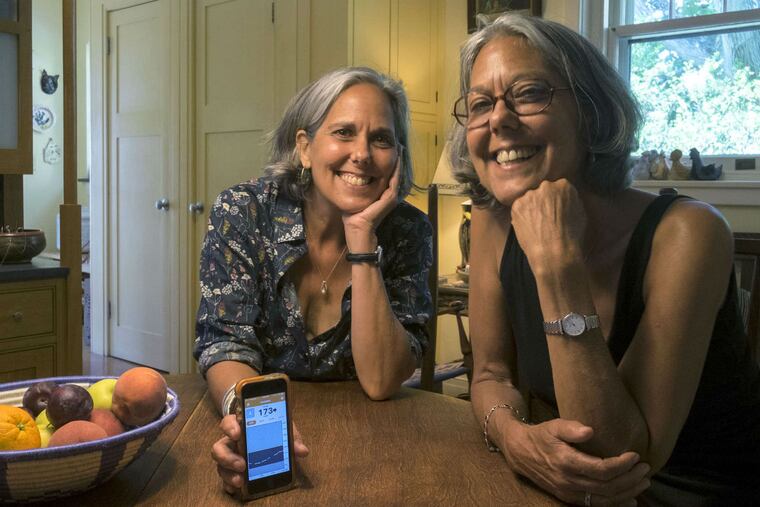Monitoring diabetes from near and afar
Nancy Warren's eyes snapped open at 2 a.m. one recent night. She automatically looked over at her phone, where she could see a continual display of her sister's blood-sugar reading.

Nancy Warren's eyes snapped open at 2 a.m. one recent night. She automatically looked over at her phone, where she could see a continual display of her sister's blood-sugar reading.
It was so low, Warren grabbed the phone and started dialing.
Warren, 58, who lives in Haverford, tried repeatedly to reach her twin sister, Kim Scharff, in St. Louis, but Kim never answered the phone. For the next five hours, Warren, who does her best to monitor her sister's Type 1 diabetes from about 900 miles away, imagined the worst.
When Scharff finally called back at 7 a.m., Warren tried to stay calm.
"You've been low since 2 a.m.," she said as gently as she could in her panic.
"Then, as it dawned on Kim's foggy morning brain that I had been trying to reach her for five hours, she felt bad for me."
The sisters have lived apart for 40 years, when they left home for college in different states. Now, new kinds of personal health technology help bridge miles - and raise challenges of their own.
"The monitor helps us track her, but we have had to learn to manage the closeness it allows us," Warren said. "Sometimes she will just turn it off for a while. If I get worried, I will ask her to turn it back on."
Nearly 50 years ago, when the sisters were 11, they went to sleepaway camp for the summer. Despite eating ravenously, Scharff kept losing weight.
"We were only allowed one phone call a day, and I couldn't reach my parents," she recalled. "The nurse kept giving me aspirin because she had no clue what she was doing."
By the end of the summer, she was seriously ill, though she still remembers that the worst of it was the emotional pain.
"It was embarrassing when you're 11 to be different," she said.
Diabetes has made the sisters' close bond both more important and, sometimes, tougher.
"I am the constant reminder of what it would be like for her if she didn't have diabetes," Warren said. "We are so lucky that we have each other, but that is the difficult part of our twindom."
But having the ability to monitor her sister's health 24/7 through an app on her cellphone brings peace of mind.
The Dexcom continuous glucose monitor (CGM), a small, wearable device that tracks Scharff's glucose throughout the day and night, notifies Scharff, her husband, and her sister of highs and lows. A small filament placed just below her skin has an enzyme that reacts to glucose, generating a tiny electric current that is converted into blood glucose values. She must still use finger sticks - pricking her finger to get a drop of blood for testing - three times a day to calibrate the CGM.
"These continuous monitors are a game-changer in how we treat and how we manage diabetes," said Gary Scheiner, owner and clinical director of Integrated Diabetes Services in Wynnewood, a company that trains insulin users in blood-sugar management. "What's really valuable is that it gives you trending information if your blood glucose level is rising or falling."
Knowing that puts patients in a better position to anticipate changes and act accordingly.
"People with diabetes make 50 or 60 decisions a day related to their blood sugar about food intake, physical activity, and insulin doses," Scheiner said. There is also a warning system built in that alerts the user if they are trending too high or too low, which can be lifesaving.
It's not cheap, though costs are covered by most health insurers. The unit costs between $500 and $1,000 plus an additional $80 to $100 for sensors that must be replaced each week or two.
In 2012, 29.1 million Americans, or 9.3 percent of the population, had diabetes, including about 1.25 million Americans with Type 1, the most serious form of the disease, according to the American Diabetes Association.
In Type 1, the pancreas stops producing insulin altogether. "Without insulin, there's no way to remove the sugar from the bloodstream and life cannot be sustained," said Cheryl Marco, a certified diabetes educator with the division of endocrinology at Thomas Jefferson University.
So, while all people with diabetes must monitor their blood sugar for highs and lows, "many people with Type 1 diabetes check their blood sugar as many as 10 or 15 times a day to manage the give and take," Marco said.
One system designed to protect against lows is a combination pump and CGM made by Medtronic. If the blood sugar goes below a certain level, but the person is unable to hear and respond to the alarm, the pump will automatically turn off insulin delivery.
"For the person who is at risk of lows and thus not hearing the alarm and waking up, this is truly revolutionary," Marco said. "They can go to bed at night and not have to be worried."
Not worrying, however, is a tall order, especially for the sister who sometimes wakes up in the middle of the night to grab her phone for reassurance.
"Kim's the one who has to have diabetes, so if I can help her with it, that makes me feel a little bit better and more involved," Warren said. "Kim is very good at taking care of herself, but as an outsider, especially if I'm in Philadelphia and Kim's in St. Louis, it's easier for me to look at it over a few days and say, 'Kim, you've been low at 5 every day.' I can look at patterns."